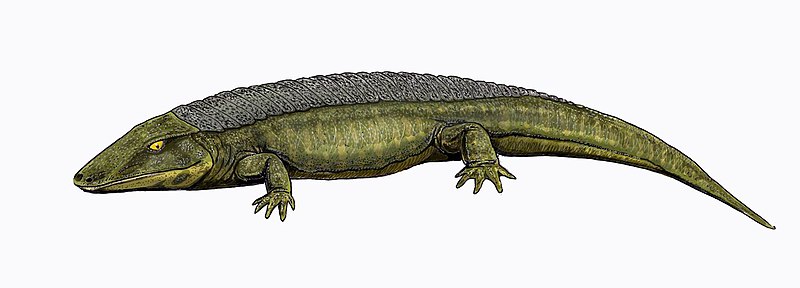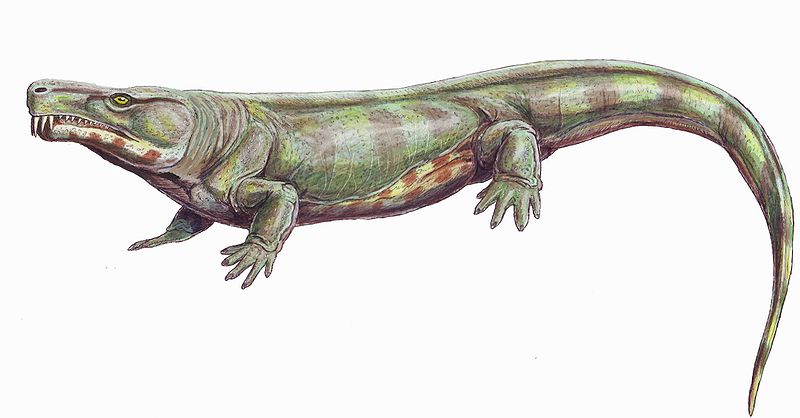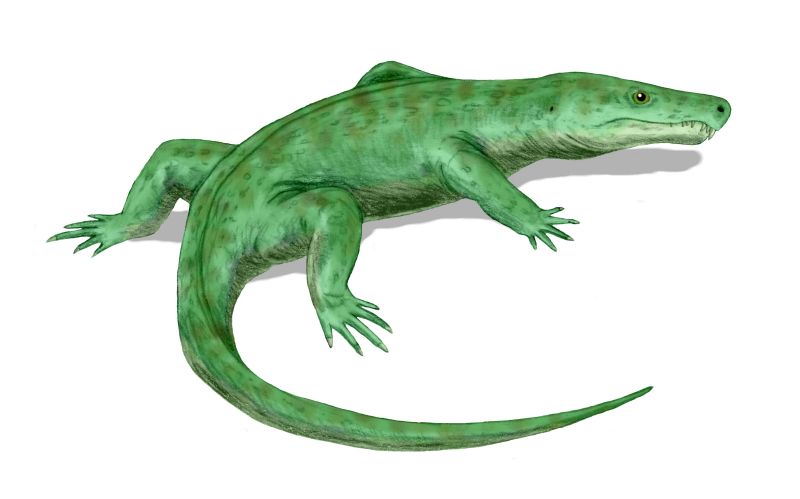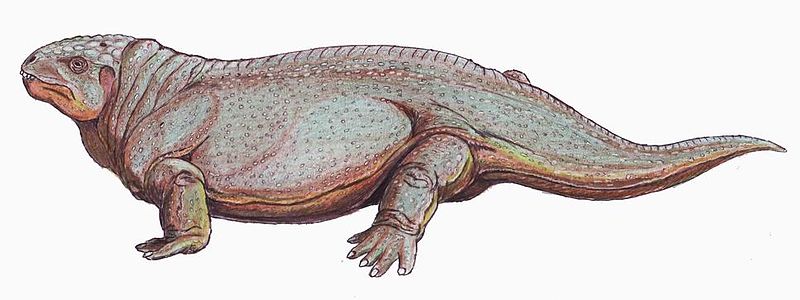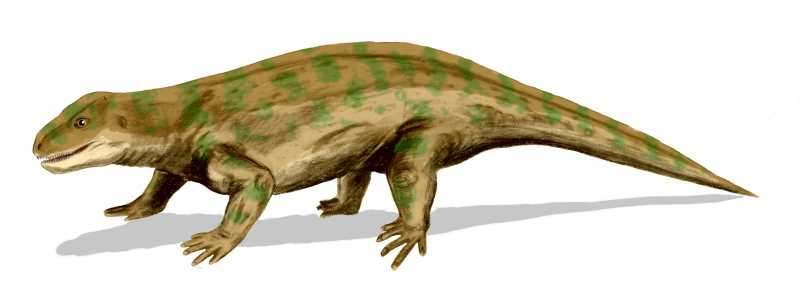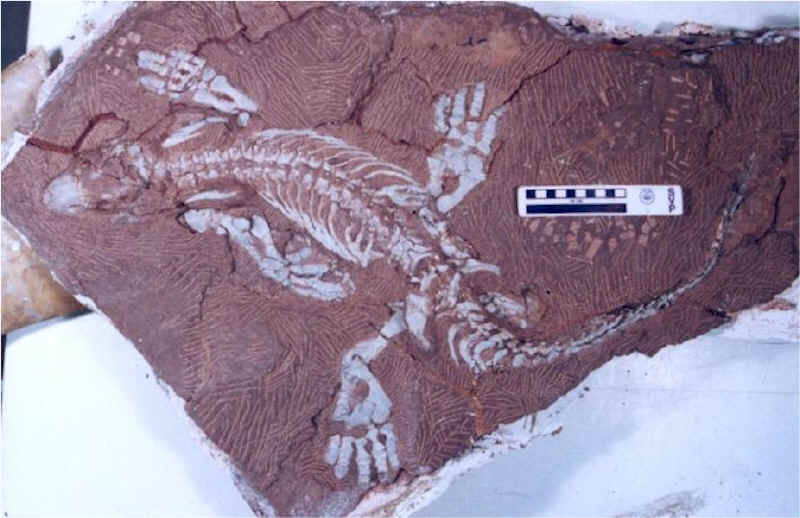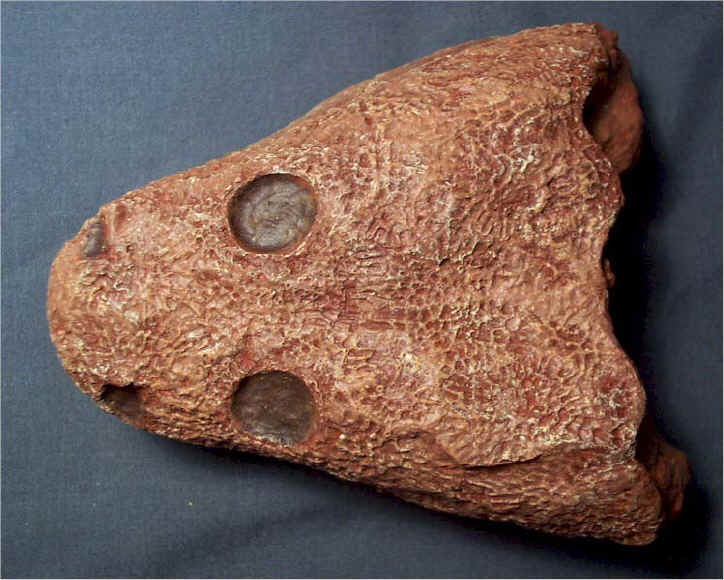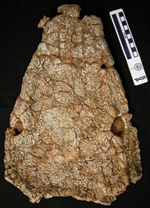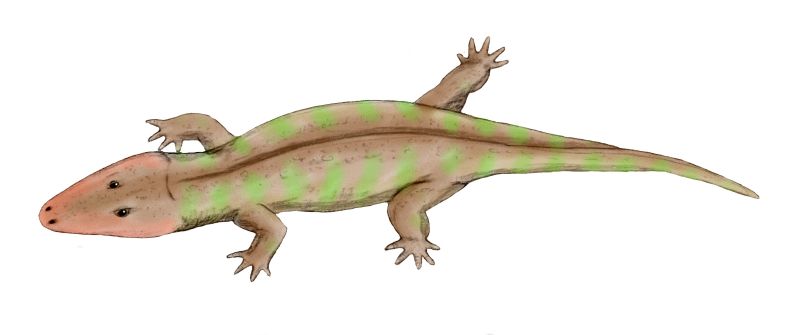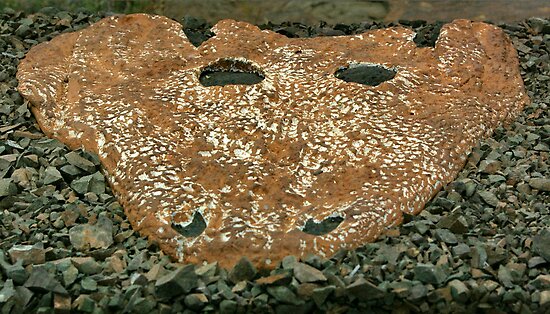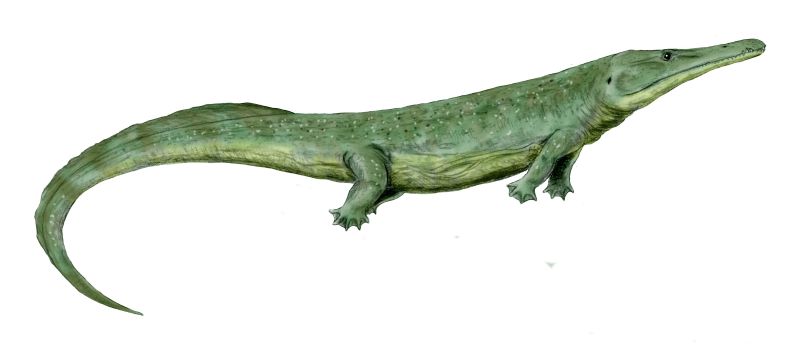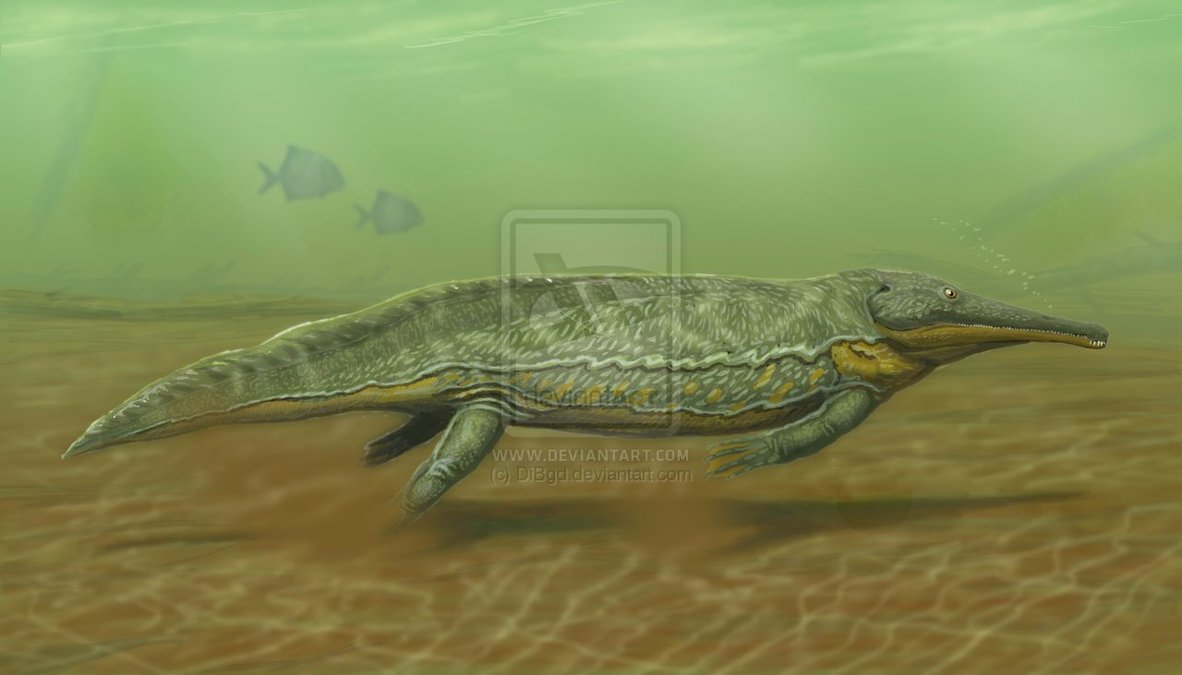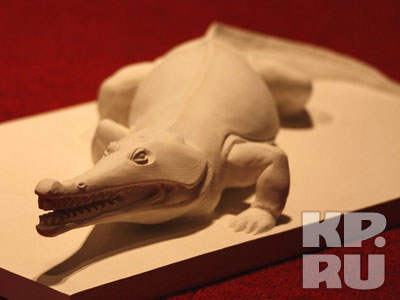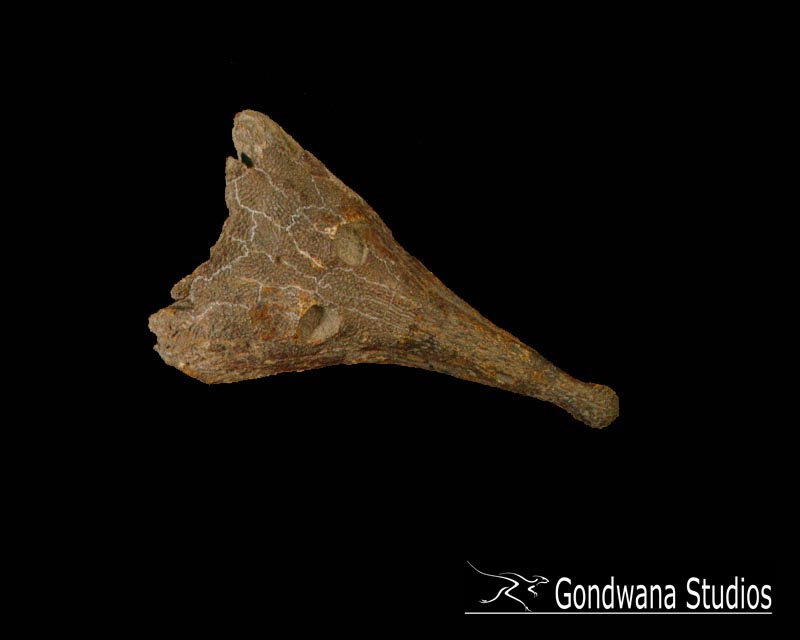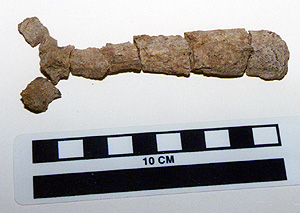[Recent Entries][Archive][Friends][User Info]
Below are 20 entries, after skipping 40 most recent ones in the "Сообщество, посвящённое ра" journal:[<< Previous 20 entries -- Next 20 entries >>]
| October 28th, 2011 | |
|---|---|
| 06:20 pm [industrialterro] [Link] |
Chroniosuchus Chroniosuchus is an extinct genus of chroniosuchid reptiliomorph from upper Permian (upper Tatarian age) deposits of Arkhangelsk, Orenburg and Vologda Regions, Russia. It was first named by Vjuschkov in 1957 and the type species is Chroniosuchus paradoxus. Хрониозухи (Chroniosuchidae) — семейство примитивных рептилиоморфов, близких к антракозаврам-эмболомерам. Населяли водоемы Восточной Европы в конце пермского периода (позднетатарская эпоха). Внешне напоминали небольших крокодилов. Череп довольно низкий, с фонтанелями (ниже и впереди глазниц и между ноздрями), иногда с невысокими гребнями на крыше черепа. Вдоль спины — ряд костных щитков, соответственно каждому позвонку. Число щитков достигало 30 (от затылка до передней трети хвоста). Череп и щитки покрыты разнообразной сложной скульптурой, имеющей важное диагностическое значение. У некоторых видов щитки широкие (покрывают всю спину), у некоторых — узкие. Семейство Chroniosuchidae содержит четыре рода и шесть видов:
Длина черепа хрониозухий от 20 до 55 см, самый крупный вид — Uralerpeton tverdochlebovae, мог достигать 2,5 метров в длину. Рыбоядные, преимущественно водные хищники. Возможно, населяли соленые озера — в фонтанели черепа могла быть солевая железа. Хрониозухи имеют важное стратиграфическое значение (руководящие ископаемые позднетатарского яруса). К семейству Chroniosuchidae близко семейство Bystrowianidae (см Bystrowiana) — полуназемные панцирные рептилиоморфы начала триаса. Оба семейства объединяют в группу Chroniosuchia. Это последние из примитивных рептилиоморфов.
Tags: Антракозавры, Вымершие амфибии, Лабиринтодонты, Пермь |
| 06:03 pm [industrialterro] [Link] |
Tseajaia Tseajaia is an extinct genus of tetrapod. It was an anthracosaurian that lived in the Permian of North America. The skeleton is that of a medium sized, rather advanced reptile-like amphibian. In life it was about a meter (3 ft.) long and may have looked vaguely like an iguana, though slower and and with a more amphibian foot without claws. The dentition was somewhat blunt, indicating herbivory or possibly omnivory. Tseajaia was described from a single, fairly complete specimen and was given its own family by Robert L. Carroll. It was originally thought to be an seymouriamaorph. Additional finds allowing for a better taxonomic analysis indicate they belong in the Diadectomorpha, as the sister group to the large and more derived Diadectidae. Tseajaia itself being a fairly generalized form, gives a reasonable indication of the build and looks of the closest relatives of the amniotes.
Tags: Антракозавры, Вымершие амфибии, Лабиринтодонты, Пермь |
| October 27th, 2011 | |
| 09:51 pm [industrialterro] [Link] |
Limnoscelis Лимносцелис (Limnoscelis) — примитивное четвероногое позднекаменноугольной — раннепермской эпохи. Считается либо «парарептилией», близкой к диадектам и парейазаврам, то есть амниотой, либо антракозавром, то есть «амфибией»-рептилиоморфом. Крупное животное, с черепом длиной до 27 см, общая длина до 2 метров. Череп анапсидный, треугольный, с узкой мордой и очень широким затылком. Ушная вырезка не развита. Кончик морды высокий. Зубы простые, конические, острые. Обращают на себя внимание чрезвычайно развитые «резцы» верхней челюсти. Тело длинное, ноги короткие, мощные, элементы кисти и стопы слабо окостеневшие. Хвост длинный, у основания сжатый с боков. Шея, как и у большинства примитивных тетрапод, очень короткая. Вероятно, полуводный хищник. Тем не менее, следует отметить, что «конструкция» черепа сильно отличается от таковой крокодилов, что предполагает совершенно другой способ охоты. Возможно, охотился на мелких тетрапод на мелководье. Описан С. В. Виллистоном в 1911 году, типовой вид — L. paludis. Описание сделано на основании скелетов двух особей из переходных пермокарбоновых отложений Нью–Мексико (Рио-Арриба). По возрасту отложения соответствовали формации Або/Катлер. Позднее остатки лимносцелисов обнаружили в позднекарбоновых — раннепермских отложениях всего Юго-Запада. Типовой экземпляр, замечательно сохранившийся, видимо «тихо умер в мелком пруду», как писал С. Виллистон. Близкие роды Limnosceloides и Limnoscelops известны также из ранней перми США.
Tags: Антракозавры, Вымершие амфибии, Лабиринтодонты, Пермь |
| 09:33 pm [industrialterro] [Link] |
Orobates Orobates is an extinct genus of diadectid. It lived in the middle Permian, about 260 million years ago. Its remains were found in Germany. A combination of primitive and derived traits makes Orobates the sister group of all Diadectidae, the most primitive known member of the family of generally large bodies herbovorious reptil like amphibians. It appears to have been part of an uppland fauna, browsing on high fibre plants. The trace fossil species Ichniotherium sphaerodactylum, from Bromacker in Germany has been attributed to Orobates, showing dragmarks from the tail. The genus was characterized by a long body and tail, with fairly short legs and a short skull compared to the more derived Diadectes. This indicate Oreobates was less specialised for long treks compared to Diadectes.
Tags: Антракозавры, Вымершие амфибии, Лабиринтодонты, Пермь |
| 09:26 pm [industrialterro] [Link] |
Diasparactus Diasparactus is an extinct genus of diadectid. In Diasparactus, the spines of the dorsal vertebrae are higher than in other genera in the family. In 1910, E. C. Case described Diasparactus zenos from a few vertebrae found in New Mexico. In 1911, a largely intact skeleton was found in the same area. The vertebrae agreed with the described type species and the new find was considered likely to be the same species. The total length of the animal when restored was 1.35 metres. The skull measured 16.7 centimetres. It was in poor condition but was similar to that of Diadectes lenius and Animasatirus carinatus. The nares and orbits were in similar positions and there were fourteen teeth with possibly a rudimentary fifteenth, a dentition typical of the family. The vertebrae, ribs and limbs were described in detail. The carpals were mostly present and still in position, - the best preserved examples for a diadectid then found. The foot was broad and strong with short phalanges. The feet and limbs supported the view that this animal was a marsh-dweller and probably a slow-moving herbivore.
Tags: Антракозавры, Вымершие амфибии, Лабиринтодонты, Пермь |
| 09:01 pm [industrialterro] [Link] |
Diadectes Diadectes (meaning biter-through or penetrating bite) was a genus of large, very reptile-like amphibians that lived during the early Permian period (Cisuralian - Guadalupian epochs, between 299 and 271 million years ago). It is one of the very first herbivorous tetrapods, and also one of the first fully terrestrial animals to attain large size. Diadectes was a heavily built animal, 1.5 to 3 meters long, with a thick-boned skull, heavy vertebrae and ribs, massive limb girdles and short, robust limbs. The nature of the limbs and vertebrae clearly indicate a terrestrial animal. It possesses some characteristics of reptilians and amphibians, combining a reptile-like skeleton with a more primitive, seymouriamorph-like skull. Diadectes has been classified as belonging to the sister group of the amniotes. Among its primitive features, Diadectes has a large otic notch (a feature found in all labyrinthodonts, but not in reptiles) with an ossified tympanum. At the same time its teeth show advanced specialisations for a herbivorous diet that are not found in any other type of early Permian animal. The eight front teeth are spatulate and peg-like, and served as incisors that were used to nip off mouthfuls of vegetation. The broad blunt cheek teeth show extensive wear associated with occlusion, and would have functioned as molars, grinding up the food. It also had a partial secondary palate, which meant it could chew its food and breath at the same time, something many even more advanced reptiles were unable to do. These traits are likely adaptations related to the animals high fiber herbivorous diet, and evolved independently of similar traits seen in some reptilian groups. Many of the reptile-like details of the post-cranial skeleton are possibly related to carrying the substantial trunk, these may be independetly derived traits on Diadectes and their relatives. Though very similar, they would be anaologous rather than homologous to those of early amniotes like pelycosaurs and pareiasaurs, as the first reptiles evolved from small, swamp dwelling animals like Casineria and Westlothiana. Диадекты (Diadectes) — род примитивных четвероногих позднего карбона — ранней перми. Считаются примитивными амниотами (парарептилиями) либо рептилиоморфами — антракозаврами. В инфраклассе завропсид входят в отряд котилозавров, либо выделяется в отряд диадектоморфов, более примитивных, чем прочие амниоты. Описаны Э. Д. Коупом в 1878 году. В большинстве своём крупные животные — длина самых крупных видов превышала 3 метра, а длина черепа — до 50 см. Череп очень массивный, анапсидный, крыша черепа толстая, губчатая. Глубокие «ушные» вырезки, образованные квадратной костью, как у амниот. Очень крупное отверстие теменного глаза. Щёчные зубы поперечно расширены, передние зубы долотовидные, наподобие резцов млекопитающих. Есть примитивное вторичное нёбо. Скелет у крупных видов массивный, хвост короткий, конечности относительно короткие, толстые. Ногтеобразные когти, возможно, отражают приспособление к полуроющему образу жизни. Диадекты — самые первые из настоящих растительноядных тетрапод. Тем не менее, истинный характер их питания остаётся неизвестным — высказывались предположения об их питании моллюсками. Не исключено, что диадекты поедали какую-то растительную пищу, заключённую в твёрдую оболочку (плоды? ткани ствола саговников?). Крупные диадектиды могли быть относительно привязаны к влажным биотопам, но мелкие виды (типа D. absitus из Бромакера) были вполне сухопутными. Остатки диадектид относительно редки в захоронениях. Примерно 14 видов из позднего карбона — ранней перми Юга США (Техас, Нью-Мексико, Оклахома) и Германии (Бромакер). Самые крупные виды (D. phaseolinus, D. tenuitectus, D. maximus) — североамериканские из формации Уичита. Близкие к диадекту Orobates (ранняя пермь Бромакера), Phanerosaurus (ранняя пермь Сахена в Германии), Diasparactus, Desmatodon (ранняя пермь США, Нью-Мексико) — относительно мелкие животные, до 1,5 метров длиной. Диадектиды вымерли в конце ранней перми, возможно, вытесненные казеидами.
Размеры тела в сравнении с человеком:
Ископаемые останки (1, 2, 3, 4):
Tags: Антракозавры, Вымершие амфибии, Лабиринтодонты, Пермь |
| 08:55 pm [industrialterro] [Link] |
Zygosaurus Zygosaurus is an extinct genus of dissorophoid temnospondyl from the Middle Permian of Russia. Большой исторический интерес представляет крупный диссорофид зигозавр (Zygosaurus lucius). Его череп был обнаружен майором фон Кваленом в 1847 году в Ключевском руднике в Оренбургской области. Род описан Эйхвальдом в 1848 году. Это одна из первых находок позвоночных в медистых песчаниках Приуралья. Череп зигозавра высокий, удлиненно-овальный, сильно скульптированный, длина черепа до 17 см (по Эйхвальду — «длина 4 вершка, ширина 3 вершка»). Череп резко сужается впереди глазниц, расширяется в височной области и вновь сужается к затылку. Огромное теменное отверстие. Крупные конические зубы. По возрасту он принадлежит к ишеевскому комплексу — это последний из известных диссорофид. К сожалению, кроме черепа, других костей этого темноспондила не известно.
Tags: Вымершие амфибии, Лабиринтодонты, Пермь, Темноспондилы |
| 08:37 pm [industrialterro] [Link] |
Trimerorhachis Trimerorhachis is an extinct genus of dvinosaurian temnospondyl within the family Trimerorhachidae. It is known from the Early Permian of Texas. Its fossils are very common in the north-central part of the state. The type species of Trimerorhachis, T. insignis, was named by American paleontologist Edward Drinker Cope in 1878. A second species, T. sandovalensis, was named from New Mexico in 1980. The length of the largest specimens of Trimerorhachis is estimated to have been almost a metre (3.3 feet) in length. Trimerorhachis has a large triangular head with upward-facing eyes positioned near the front of the skull. The trunk is long and the limbs are relatively short. The presence of a branchial apparatus indicates that Trimerorhachis had external gills in life, much like the modern axolotl. The body of Trimerorhachis is also completely covered by small and very thin osteoderms, which overlap and can be up to 20 layers thick. These osteoderms act as an armor-like covering, especially around the tail. Their weight may have helped Trimerorhachis sink to the bottom of lakes and rivers where it would feed. Trimerorhachis was a fully aquatic temnospondyl. Like most dvinosaurs, it had external gills. The interclavicle and clavicle of the pectoral girdle are both very large, a feature that is shared with other aquatic temnospondyls. Many bones are poorly ossified, indicating that Trimerorhachis was poorly suited for movement on land. Trimerorhachis was probably an aquatic predator that fed on fish and small vertebrates. During the Early Permian, the area of New Mexico and Texas was a broad coastal plain that stretched from an ocean in the south to highlands in the north. Other common animals that lived alongside Trimerorhachis included lungfish and crossopterygians, the lepospondyl Diplocaulus, and the large sail-backed synapsid Dimetrodon. Small bones that likely belong to immature Trimerorhachis individuals have been found in the pharyngeal pouches of larger Trimerorhachis specimens. At first these bones were thought to be part of the branchial arches which surround the pouch, or remains of prey that had just been eaten before the animal died. If Trimerorhachis was a mouth brooder, the closest living analogue would be Darwin's Frog, which broods its young in its vocal sac. The bones in Trimerorhachis belong to juveniles that were much larger than those of Darwin's Frog, however. The young of the Gastric-brooding frog of Australia are comparable in size to those of Trimerorhachis but are brooded in the stomach rather than the throat. The number of brooded young in Darwin's Frog and the Gastric-brooding frog is also much higher than that of Trimerorhachis, as only a few individuals can be distinguished in the collection of bones. The only living amphibian that raises similarly sized young is the Golden coquí, although it does so through ovovivipary rather than brooding. Another possible explanation for the small bones is that they were originally located in the throat and were pushed into the pharyngeal pouch during fossilization. If this was the case, Trimerorhachis may have eaten its young instead of brooding them. This type of cannibalism is widespread in living amphibians, and most likely occurred among some prehistoric amphibians as well.
Ископаемые останки (1, 2, 3, 4):
Tags: Вымершие амфибии, Лабиринтодонты, Пермь, Темноспондилы |
| 08:25 pm [industrialterro] [Link] |
Tambachia Tambachia is an extinct genus of dissorophoid temnospondyl within the family Trematopidae. It is known from the Early Permian Tambach Formation (the lowermost unit of the Upper Rotliegend) near the town of Tambach-Dietharz in Thuringia, Germany. Tambachia is the first trematopid to have been discovered outside the United States. The skull of MNG 7722 is severely crushed dorsoventrally, making it hard to determine the shape of the skull in lateral view. It is 6.9 centimetres (2.7 in) in length, which is small for a trematopid. The orbits, or eye sockets, are centrally placed so that the preorbital length of the skull is equal to that of the postorbital length. They make up around 30% of the skull length. The skull table seems to extend posteriorly past the level of the jaw articulation in Tambachia, which is unique among trematopids. However, this is likely to have been the result of crushing of the skull, which displaced the skull table. Tambachia, like other trematopids, likely possessed a salt gland similar to those seen in modern reptiles. The subdivision of the external naris into anterior and posterior portions is evidence of the presence of salt glands. The anterior portion is sub-circular and is thought to be the true narial opening. The posterior portion likely held the salt gland. The expansion of the posterior portion may not be an accommodation for the salt gland, but rather a means of coping with cranial stresses during feeding. The postcranial skeleton is well known in Tambachia, given the completeness of the holotype specimen. The relatively short tail, preserved only as a faint impression in MNG 7722, is 8.5 centimetres (3.3 in) long. The limbs are short, with four digits on the manus, or hand, and five digits on the pes, or foot. It is possible that the manus possessed five digits, since Acheloma, another closely related trematopid, has been described as having five distal carpals. In the pes of the holotype specimen, there are only four digits preserved. However, since the third preserved digit is the longest, it likely represents the fourth digit, with the first digit absent due to imperfect preservation. The terminal phalanges of Tambachia were narrow, and would have been the core supports of claws. Тамбахия (Tambachia trogalles) – из ранней перми (вольфкамп) Германии. Это единственный трематопид, найденный вне Северной Америки. Тамбахия входит в знаменитую фауну Бромакера. Мелкое животное, с длиной черепа около 5 см, с короткой мордой и большими глазами.
Tags: Вымершие амфибии, Лабиринтодонты, Пермь, Темноспондилы |
| 08:16 pm [industrialterro] [Link] |
Saharastega Saharastega is a genus of prehistoric amphibian which lived during the late Permian period, around 251 to 260 million years ago. Remains of Saharastega discovered by paleontologist Christian A. Sidor at Moradi Formation, in Niger and was described briefly in 2005 and with detail in 2006. The description is based on a skull lacking the lower jaws. Paleontologists suggest that along with Nigerpeton, Saharastega is the first basal genus of the Temnospondyli, a group of prehistoric amphibians. К указанным семействам может быть близок еще один темноспондил из поздней перми Марокко — Saharastega moradiensis. Череп плоский, округлый, с сохраненной подвижностью между костями. Длина черепа до 37 см. Морда довольно длинная, глаза сдвинуты к боковым поверхностям черепа, направлены вбок. Челюстной сустав сдвинут вперед, что необычно для темноспондилов. Небо покрыто мелкими зубчиками. Борозд боковой линии нет. Видимо, как и нигерпетон, представляет последнего представителя своей линии, выжившего в условиях изоляции посреди пустынь. Тем не менее, родство сахаростеги с эдопоидами в последнее время подвергается сомнению.
Tags: Вымершие амфибии, Лабиринтодонты, Пермь, Темноспондилы |
| 08:08 pm [industrialterro] [Link] |
Rhynchonkos Rhynchonkos — вымерший род микрозавров. Единственный род семейства Goniorhynchidae. Ранее известный как Goniorhynchus получил современное название в 1981 году. Единственный вид — R. stovalli. Обнаружен в формации Хеннеси (округ Кливленд, Оклахома) раннего пермского периода. Rhynchonkos обладает существенным сходством с ранними безногими земноводными раннего юрского периода Eocaecilia, найденными в Аризоне. Считалось, что безногие земноводные произошли от микрозавров, что сейчас оспаривается. Rhynchonkos has an elongated body with at least 37 presacral vertebrae. Most vertebrae have ribs. Unlike other microsaurs, the atlas of Rhynchonkos lacks ribs. Both Rhynchonkos and Euryodus have atlases that bear a strong resemblance to those of nectrideans. Like nectrideans, the arch of the atlas is attached to the centrum, although this is likely the result of convergence. The skull is triangular in dorsal view. The limbs are very small. It has a pointed, overhanging snout that extends beyond the tooth row. There are five or six premaxillary teeth and sixteen maxillary teeth, all of which are narrow and peg-shaped. The palate also has teeth, with rows on the ectopterygoid, palatine, and vomer. The bones of the skull roof are similar to those of gymnarthrids. There are two rows of teeth adjacent to one another in the lower jaw, with a marginal row on the dentary and an inner row on the coronoid. Rhynchonkos shares many features with the early caecilian Eocaecilia, including an elongated trunk, small limbs, and a similar skull. Based on these features, caecilians seemed to have originated from Rhynchonkos or another closely related microsaur. Carroll and Currie (1975), the first to suggest this possible relationship, noted similarities in temporal fenestration, palatal structure, braincase composition, and mandibular dentition. In the temporal region of the skulls of Rhynchonkos and caecilians, the number of bones are reduced. Both Rhynchonkos and caecilians possess a primitive combination of palatal bones, including the ectopterygoid. The two taxa also have rows of teeth on the palate in addition to the marginal rows on the maxilla and premaxilla. Carrol and Currie also mentioned that Rhynchonkos and caecilians have a pleurosphenoid that joins the otic-occipital portion of the braincase with the sphenethmoid, a characteristic which they considered unique among amphibians. The adjacent tooth rows on the coronoid and the dentary of Rhynchonkos were also considered a characteristic that linked it with caecilians. Despite these similarities, many of the characteristics that suggested a close relationship between Rhynchonkos and caecilians have since been considered primitive, convergent, or indeterminate. For example, tooth rows on the palate have evolved multiple times independently in early amphibians. The general appearance of Rhynchonkos is similar to that of caecilians, but is also similar to other amphibians that have independently developed elongated bodies. Adelospondyls, lysorophians, aïstopods, and some salamanders all have an increased number of vertebrae that lengthen the body. Reduced limbs are seen in many aquatic or burrowing amphibians, and are not unique to microsaurs and caecilians.
Tags: Вымершие амфибии, Лабиринтодонты, Лепоспондилы, Пермь |
| 07:56 pm [industrialterro] [Link] |
Rhinesuchus Rhinesuchus is a large temnospondyl amphibian. Fossil remains of the genus are known from the Permian of the South African Karoo Basins Tapinocephalus and Cistecephalus assemblage zones, both of the Beaufort Group.
Tags: Вымершие амфибии, Лабиринтодонты, Пермь, Темноспондилы |
| October 26th, 2011 | |
| 08:56 pm [industrialterro] [Link] |
Prionosuchus Prionosuchus is a genus of extremely large temnospondyl amphibians from the Late Permian (270 million years ago) which was found in an area of what is now Brazil. The fragmentary remains of this animal have been found in the Pedra do Fogo Formation in the Parnaiba Basin of Northeastern Brazil, and it was described by L.I. Price in 1948. Reaching an estimated length of 9 m (30 ft), Prionosuchus is the largest amphibian ever found. With an elongated and tapered snout, numerous sharp teeth, long body, short legs, and a tail adapted for swimming, its general appearance was very similar to a modern crocodile, particularly to the gharial, and it probably had a similar lifestyle as an ambush aquatic predator feeding on fish and other aquatic animals. It has been classified as an archegosaurian by Carroll. The genus is monotypic with P. plummeri being the only species described. The archegosaurs were a group of temnospondyli that occupied the ecological niche of crocodiles and alligators during the Permian, and of which the European genus Archegosaurus is typical. The group went extinct at the end of the Permian and the niche was subsequently filled by reptiles such as the phytosaurs in the Triassic period. Cox and Hutchinson re-evaluated Prionosuchus in 1991 and synonymized it with the genus Platyoposaurus from Russia. On the basis of this study, the Pedra do Fogo Formation was reevaluated to be of Middle to Late Permian age. However, Platyoposaurus was comparatively smaller, reaching a total length of only 2.5 meters (8.2 ft), indicating that the two animals are distinct at least at the species level. Alternative studies based on plants and pollens indicate that this formation is rather of Early Permian age, making Prionosuchus not contemporary with Platyoposaurus. Most paleontologists consider Prionosuchus as a valid genus. Prionosuchus lived in a humid and tropical environment as indicated by the petrified forest of the Pedra do Fogo formation in which the fossil has been found. The strata composed of siltstones, shales and limestones were deposited in lagoonal and fluvial environments. Other animals discovered in the same rocks include fish (primitive sharks, palaeoniscids, and lungfishes) and amphibians. Интересно, что очень близкие к платиопозавру темноспондилы обнаружены в пермских отложениях Южной Америки. Первым из них был прионозух (Prionosuchus plummeri), описанный Л. Прайсом в 1948 году из пермских отложений Педра де Фого в Северной Бразилии. Первоначально найденные куски черепа принадлежали некрупным особям, но в 1970-х годах был обнаружен ростр прионозуха длиной около 80 см, что предполагает длину черепа более 160 см! Общая длина животного могла превышать 6 - 7 метров. Прионозух отличается чрезвычайно узким ростром. Череп пневматизирован, как у крокодилов. Мягкие ткани неба были покрыты костными пластинками, усаженными мелкими зубчиками. По-видимому, прионозух обладал короткими слабыми конечностями – возможно, он не покидал воду. Он мог населять крупные озера. Единственным другим ископаемым в слоях Педра де Фого является некрупная рыба Brazilichthys, представитель палеонисков. Не исключено, что прионозух относится к роду Platyoposaurus, но истинный возраст формации Педра де Фого не известен – он может быть и раннепермским, и позднепермским. Находки платиопозавров как в Северном, так и в Южном полушарии подтверждают существование в пермскую эпоху связи между Гондваной и северными континентами.
Размеры тела в сравнении с человеком:
Tags: Вымершие амфибии, Лабиринтодонты, Пермь, Темноспондилы |
| 08:41 pm [industrialterro] [Link] |
Platyoposaurus Платиопозавр (Platyoposaurus) – род пермских темноспондилов. Представитель семейства Archegosauridae, подсемейства Platyoposaurinae. В старой литературе известен как платиопс (Platyops). Отличается длинной, резко суженной ростральной частью черепа, с ложковидным озубленным расширением на концах челюстей. Наружные ноздри щелевидные, плохо заметны на ископаемых черепах, сдвинуты назад. Ушные вырезки узкие. В заглазничной части черепа бугры на таблитчатых костях и впереди ушных вырезок. Зубы довольно крупные, особенно на концах челюстей. Тело массивное, коренастое, уплощенное, примерно 22 предкрестцовых позвонка. Сильно развиты крючковидные отростки туловищных ребер. Брюхо покрыто мелкими удлиненно-овальными чешуями, спинных чешуй не обнаружено. Конечности довольно длинные, особенно задние. Высокие остистые отростки, особенно на основании хвоста. Хвост не очень длинный, уплощенный с боков. В целом животное напоминало небольшого (до 2 метров длиной) длинномордого крокодила. (Особенно велико внешнее сходство с вымершими раннеюрскими крокодилами типа Pelagosaurus.) Вероятно, рыбоядный хищник, скорее всего постоянноводный (поскольку, в отличие от крокодилов, с сушей его ничего не связывало). Типовой вид - P. rickardi, описанный В. Твелвтризом в 1880 году по разрозненным остаткам из медистых песчаников Приуралья. Гораздо более полно известны два других вида - P. stuckenbergi и P. watsoni. Платиопозавр Штукенберга известен по практически полному скелету, но ростральная часть его черепа плохо сохранилась. С другой стороны, платиопозавр Уотсона (описанный И.А. Ефремовым в 1932 году) известен по полному черепу,более того, в местонахождении Шихово-Чирки обнаружено захоронение множества особей этого вида. Платиопозавры являются руководящими ископаемыми середины пермского периода (верхнеказанская – нижнетатарская эпоха). Более мелкие виды (P. rickardi и P. watsoni) характеризуют голюшерминский субкомплекс, а крупный P. stuckenbergi – очерский субкомплекс. Длина черепа этого вида достигала 40 см (есть указания на черепа до 70 см длиной). Среди темноспондильных амфибий, живших в конце пермского периода, платиопозавр, видимо, был наиболее «крокодилообразным». Вытянутая стрелообразная форма тела, мощные конечности с длинными пальцами, соединенными перепонками, давали возможность развить большую скорость в погоне за добычей, а пинцетообразная морда позволяла доставать добычу из подводных зарослей. Среди обитателей пресноводных водоемов платиопозавр был, видимо, одним из самых крупных (длина его тела могла достигать двух и более метров). Своеобразно были расположены зубы в челюстях платиопозавра - одиночный зубной ряд вдоль внешнего края нижней челюсти при закрывании пасти входил между двумя рядами зубов на верхней челюсти, что не давало никаких шансов пойманной добыче освободиться.
Ископаемые останки (1, 2, 3, 4):
Tags: Вымершие амфибии, Лабиринтодонты, Пермь, Темноспондилы |
| 08:21 pm [industrialterro] [Link] |
Platyhystrix Platyhystrix (meaning "flat porcupine") was a temnospondyl amphibian with a distinctive sail along its back, similar to the unrelated synapsids, Dimetrodon and Edaphosaurus. It lived during the latest Carboniferous and earliest Permian periods in Texas, about 300 million years ago. Platyhystrix may have been preyed upon by larger temnospondyls such as Eryops, or by larger carnivorous reptiles, which were becoming more common and diverse in the drier climate of the Permian. The skull was large and strongly built, with a frog-like face. Platyhystrix had a compact body, reaching 1 metre (3.3 ft) long including the tail, and its short, sturdy legs indicate a mainly terrestrial life. Platyhystrix appeared rather unusual: the dorsal vertebrae were extraordinarily lengthened, and in life they probably formed a skin-covered sail. This structure was possibly for thermal regulation, as in other animals of similar appearance, such as the pelycosaurs Dimetrodon and Edaphosaurus. The back of Platyhystrix was also covered with thick hard plates, similar to those of its near relative, Cacops.
Репродукции (1, 2, 3, 4, 5, 6, 7):
Tags: Вымершие амфибии, Лабиринтодонты, Пермь, Темноспондилы |
| 08:13 pm [industrialterro] [Link] |
Phonerpeton Phonerpeton is an extinct genus of dissorophoidean euskelian temnospondyl within the family Trematopidae. Трематопиды (Trematopidae) – семейство раннепермских темноспондилов. Входят в состав надсемейства Dissorophoidea, куда относятся самые наземные из темноспондилов. Трематопиды обладают довольно высоким черепом с удлиненной мордой. Отличия этой группы – наличие крайне удлиненных наружных ноздрей (возможно, это связано с острым обонянием и сохранением жидкости), наличие удлиненных клыковидных зубов верхней челюсти, присутствие срединной перегородки на сошниках, очень глубокие «ушные» вырезки и ряд других признаков. В отличие от диссорофид, трематопиды лишены мощных кожных окостенений. Тело длиннее, чем у диссорофид, ноги мощные, хвост средней длины. Кисть, вероятно четырехпалая (хотя для рода Acheloma изображали 5 пальцев на кисти). Длина до 60 см. Это относительно малоподвижные наземные хищники. Фонерпетон (Phonerpeton) – мелкий трематопид с длиной черепа около 10 см, с короткой мордой и очень большими глазами. Из ранней перми Техаса.
Tags: Вымершие амфибии, Лабиринтодонты, Пермь, Темноспондилы |
| 08:08 pm [industrialterro] [Link] |
Peltobatrachus Пельтобатрах (Peltobatrachus pustulatus) – необычный темноспондил позднепермской эпохи. Описан А. Панченом в 1959 году. Остатки трех особей и множество костных фрагментов были собраны Ф. Паррингтоном в позднепермских песчаниках грабена Рухуху в Танзании. Череп уплощенный, полукруглый, с очень мощной крышей, глазницы небольшие, желобков боковой линии нет. Необычный «пустулярный» орнамент крыши черепа сходен с орнаментом черепа плагиозавров. Позвонки не стереоспондильные. Очень мощный туловищный панцирь состоит из двух щитов – плечевого и тазового. Между щитами расположены поперечно вытянутые ряды костных пластинок. В целом конструкция панциря напоминает таковую у некоторых броненосцев, но у пельтобатраха панцирь покрывал и брюхо. Это самый обширный панцирь среди всех низших тетрапод. Панчен считал пельтобатраха родственником плагиозавров. Современные исследователи причисляют это животное к примитивным эускелиям, вероятно, родственным ринезухиям. Возможно, пельтобатрах был наземным или полуводным хищником. В длину он не превышал 70 см, поэтому мог питаться только некрупной добычей, возможно, и падалью.
Tags: Вымершие амфибии, Лабиринтодонты, Пермь, Темноспондилы |
| 07:57 pm [industrialterro] [Link] |
Pantylus Pantylus is an extinct lepospondyl amphibian from the Permian period of North America. Pantylus was probably a largely terrestrial animal, judging from its well-built legs. It was about 25 centimetres (10 in) long, and resembled a lizard with a large skull and short limbs. It had numerous blunt teeth, and probably chased after invertebrate prey.
Tags: Вымершие амфибии, Лабиринтодонты, Лепоспондилы, Пермь |
| 07:49 pm [industrialterro] [Link] |
Onchiodon Onchiodon is an extinct genus of temnospondyl amphibian. Onchiodon – поздний карбон - ранняя пермь Западной Европы (Франция и Германия). Длина черепа более 15 см. Примерно 4 вида. Типовой вид - O. labyrinthicus. Branchiosaurus amblystomus и Pelosaurus laticeps – мелкие «стегоцефалы» из ранней перми Западной Европы – могут быть личинками типового вида онхиодона, хотя не исключено, что это личинки Sclerocephalus.
Tags: Вымершие амфибии, Лабиринтодонты, Пермь, Темноспондилы |
| 07:39 pm [industrialterro] [Link] |
Nigerpeton Nigerpeton is a genus of temnospondyl amphibian which lived during the Permian period some 250 million years ago in Niger. Specimens of Nigerpeton were first collected during field work in the Moradi Formation in 2000 and 2003. В 2005 году из поздней перми Марокко был описан кохлеозаврид Nigerpeton ricqlesi. Это крупное животное, с длиной черепа до 45 см. Необычной особенностью, среди прочего, оказались отверстия для нижних «клыков» на небе, впереди ноздрей на кончике морды — как у мастодонзавров. Небные «клыки» многочисленны и сильно развиты, краевые зубы на челюстях разного размера. Нигерпетон — последний представитель линии кохлеозаврид. Вероятно, он сохранился в изоляции в оазисах посреди позднепермской пустыни.
Tags: Вымершие амфибии, Лабиринтодонты, Пермь, Темноспондилы |
